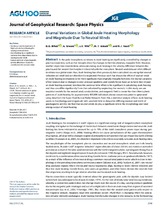| dc.contributor.author | Kosch, Mike | |
| dc.contributor.author | Billett, D. D. | |
| dc.contributor.author | Grocott, A. | |
| dc.contributor.author | Wild, J. A. | |
| dc.contributor.author | Walach, M.-T. | |
| dc.date.accessioned | 2019-08-05T11:25:00Z | |
| dc.date.available | 2019-08-05T11:25:00Z | |
| dc.date.issued | 2018 | |
| dc.identifier.citation | Billett, D. D., Grocott, A., Wild, J. A., Walach, M.-T., & Kosch, M. J. (2018). Diurnal variations in global Joule heating morphology and magnitude due to neutral winds. Journal of Geophysical Research: Space Physics, 123, 2398–2411. https://doi.org/10.1002/2017JA025141 | en_US |
| dc.identifier.issn | 2169-9402 | |
| dc.identifier.uri | https://doi.org/10.1002/2017JA025141 | |
| dc.identifier.uri | http://hdl.handle.net/10566/4767 | |
| dc.description.abstract | In the polar ionosphere, variations in Joule heating are significantly controlled by changes in
plasma convection, such as that brought about by changes in the interplanetary magnetic field. However,
another important consideration when calculating Joule heating is the velocity difference between this
plasma and the neutral thermosphere colocated with the ionosphere. Neutral wind data are often difficult
to obtain on a global scale; thus, Joule heating has often previously been calculated assuming that neutral
velocities are small and can therefore be neglected. Previous work has shown the effect of neutral winds
on Joule heating estimations to be more significant than originally thought; however, the diurnal variations
of the neutrals due to changes in solar pressure gradients and Coriolis forces have yet to have their impact
on Joule heating assessed. We show this universal time effect to be significant in calculating Joule heating
and thus can differ significantly from that calculated by neglecting the neutrals. In this study, we use
empirical models for the neutral wind, conductivities, and magnetic field to create Northern Hemispheric
patterns of Joule heating for approximately 800,000 individual plasma convection patterns generated
using data from the Super Dual Auroral Radar Network. From this, a statistical analysis of how Joule heating
varies in morphology and magnitude with universal time is shown for differing seasons and levels of
geomagnetic activity. We find that neutral winds do play a significant role in the morphology and total
energy output of Joule heating. | en_US |
| dc.language.iso | en | en_US |
| dc.publisher | Wiley | en_US |
| dc.subject | Diurnal | en_US |
| dc.subject | Heating morphology | en_US |
| dc.subject | Neutral winds | en_US |
| dc.subject | Global joule | en_US |
| dc.subject | Magnitude | en_US |
| dc.title | Diurnal variations in global Joule heating morphology and magnitude due to neutral winds. | en_US |
| dc.type | Article | en_US |

